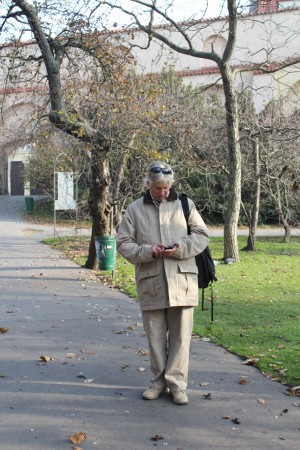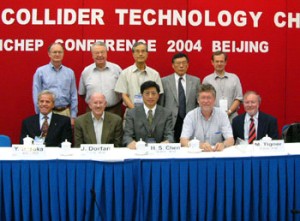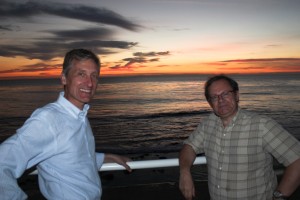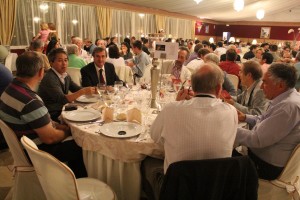In the last Director’s Corner, Harry Weerts told us about the changes to the Linear Collider Collaboration (LCC) that had been agreed by the International Committee for Future Accelerators (ICFA) at its meeting in Chicago last month. I fully support these changes; indeed I recommended many of them in a previous Director’s Corner. One of the changes is the abolition of the Regional Directors within the LCC. As Regional Director for
Europe therefore, it is time for me to emulate Harry in writing my last Director’s Corner.
This is a bittersweet task. I have been involved in Linear Collider activities since my term as Chair of the European Committee for Future Accelerators (ECFA), which was from 2002 – 2005, and have been writing Director’s Corners since the start of the Global Design Effort (GDE) in 2005. It has therefore become a challenge to come up with a topic I haven’t addressed before. On the other hand, it marks the end of more than ten years of my involvement with the coordination of world-wide ILC activities, a major fraction of my work in particle physics and therefore, for me, the end of an era.
I don’t intend to use this column to wallow in reminiscence, but rather hope to point the way ahead. I remember quoting George Santayana once before in these columns – “Those who don’t learn from history are doomed to repeat it”. Our more than ten years of activity has not after all, so far, resulted in the approval of ILC construction. Did we make mistakes, and could we have done things differently? Well, we surely did make mistakes, but I find it difficult to think of any ones that really made a difference. One thing I am certain of is that I am very proud of the work we did, particularly in the GDE. The production of the Reference Design Report in 2007 and the Technical Design Report in 2013 were major milestones towards the realisation of the ILC project. They required an enormous amount of work from everyone involved, but I want to pay tribute particularly to our leader, Barry Barish, and to the three project managers, Marc Ross, Nick Walker and Akira Yamamoto. Their incredible capacity for hard work and inspiring others was the major reason that both of the Design Reports have stood the test of time. The costing of the project has also stood that test and is the firm foundation on which further progress can be made. We have had a tougher time in the LCC, as resources dwindled away to almost nothing, but Lyn Evans has ensured that the camaraderie and esprit de corps of the old GDE carried through to the LCC. It has been a real pleasure and an honour to serve with such a group of outstanding scientists.
I mentioned the TDR costing. In retrospect, it was probably the RDR costing that was the crucial event in the last decade. It was done as carefully as we could, given the resources available, and further costing exercises have shown it was pretty accurate. Unfortunately, it was the “wrong” answer. For whatever reason, funding authorities, particularly the Department of Energy in the USA, were expecting a smaller number and the publication of the RDR cost marked a rapid retreat of interest from many countries. Perhaps we could have somehow managed expectations better than we did but the facts of the cost are what they are. We know from many years of effort that there is no “silver bullet” that will make a major reduction in the cost. One thing that hasn’t changed over the years is my conviction that the cost is worth it. Indeed the discovery of the Higgs and the current status of LHC results has strengthened my conviction that an electron-position collider up to around 1 TeV is the right future machine for our field and that the ILC is the best machine that is currently practicable.
Let me close with a few reminiscences – yes, I couldn’t resist it – and some advice and warnings for the future. The hard work on both GDE and LCC was always lightened by the many friends that I have made along the way and the extraordinary places that we have visited to think about the ILC. It is always invidious to pick examples, but who could forget the night visit to the Alhambra and another of Juan’s famous conference dinners? It was quite difficult to convince my family I was working when we had the IEEE meeting in Disneyland and the DESY crowd stayed in a house right on Laguna Beach – “Just another day in Paradise” (see picture above). How could I ever forget our expeditions trying to follow Mike Harrison’s Google Map? This photograph was taken in Prague, but Lyn has been teasing Mike for years on how he navigated us from our Tokyo hotel to the University but we ended up in the Botanical Gardens.

Navigating a huge collaboration through stressful times can sometimes be easier than navigating in a strange city.
As to the warnings, I counsel against thinking that there are major cost reductions to be made in the ILC by further R&D. In fact, as Mike Harrison pointed out recently at the Linear Collider Board meeting in Chicago, the great success of the European X-ray Free Electron Laser (XFEL) cavity production gives us a significant saving simply by upgrading the specifications for cavity voltage to be in line with the results from XFEL. By this warning I don’t mean that we should stop R&D – far from it. One of my ILC activities that will continue when I step down as Regional Director is cavity R&D with my colleagues at DESY to improve performance and reliability. However, further R&D is not a reason to delay starting construction. I think it is highly unlikely, based on the work we did for the TDR costing, that further R&D can produce cost reduction that can even keep up with inflation over the years the R&D takes.
As to advice, a couple of things occur to me. One of my recommendations in my last column was that the job of the Regional Directors of interfacing with funding authorities should be in future delegated down to country representatives. In Europe in particular, in the current status of the ILC in Japan, this is extremely important. Secondly, there must be an ongoing central activity to refine and update the ILC design as new developments occur in both the civil engineering plans at the Kitakami site and elsewhere in accelerator R&D. No accelerator design can be frozen and if we do not invest a minimum effort now then we will have to pay tenfold in the future when, as we all hope, the ILC is finally approved.
It is time to end by wishing all involved with the ILC, in particular the new management, success for the future. I will continue to watch and to work for the ILC “in the trenches”, fortified by my conviction that the ILC is still the best next machine for particle physics, just as it was all those years ago when I first heard the acronym “ILC”.





Recent Comments